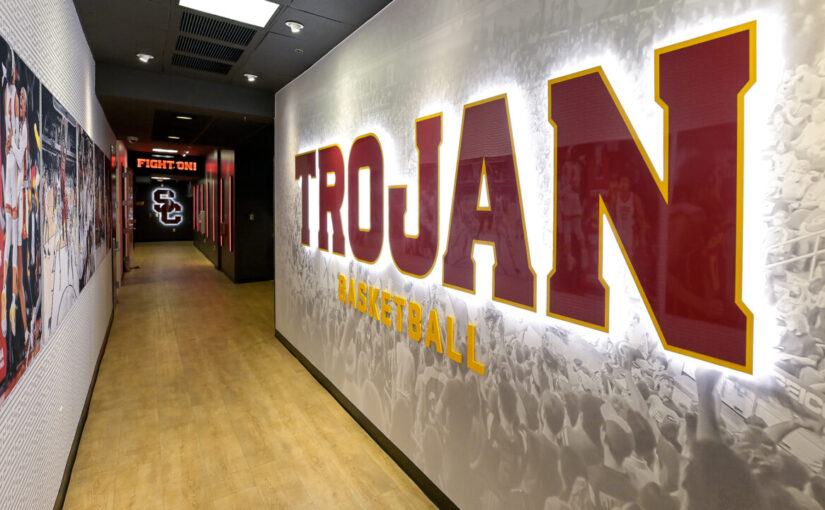Becoming the visible leader
Whether it’s at games or community events, athletic directors must put their support on full display

Often when you step on an elevator, you can hear music. It’s not bold and overwhelming, but you can hear it nonetheless. You might be able to identify the tune, but not the words to the song.
The job of an interscholastic athletic administrator can feel similar at times — when do you stand out, and when should you stay in the background? The job demands the ability to perform the many responsibilities of the position in both visible and less visible ways.The public presence as an athletic administrator can seem perfunctory at times, as athletic directors lead from up front at award ceremonies, student-athlete college signing ceremonies, individual sport parent meetings, booster club meetings, meeting with groups of student-athletes or speaking at a pep assembly. The focus of an athletic director in those events is to lead and act as a guide or master of ceremonies. These are opportunities for the athletic administrator to connect with the community in an upfront role. It might help those in the stands who wonder, “Who is that person, and what is their role at the school?”
When my daughter was playing soccer growing up, a father of one of her teammates told my daughter that I had “the best job ever because, as an interscholastic athletic administrator, I got paid to watch games.” While this is true to a degree, anyone who has lived out this role on a daily basis knows that it’s a rarity when the athletic director is actually able to sit and watch undisturbed.
The athletic administrator facing today’s numerous time and effort demands is like an iceberg — the majority mass is below the water level. Much of an athletic director’s time and effort is behind the scenes and out of sight from the masses. To be a successful athletic administrator, you must be relentlessly detail-oriented, and that work is out of sight and sound from the public view. The results of this work are visible, but the work itself is not.
Recently I called an athletic director in Oregon to ask a question, and he was in the midst of driving around picking up wrestling clocks for an upcoming tournament hosted by his school. Few know that he is the person taking care of such a mundane task, but all would know his name if the wrestling tournament were postponed due to a lack of available timing devices. These tasks are the ones that make up the majority of an athletic administrators day, to the point that it’s most comfortable place to live as an athletic director.
Growing in visibility as an athletic administrator can take place in several distinct and practical ways that assist him or her in gaining credibility and respect without appearing to communicate that the athletic program is “all about them.” Here are some ideas.
Attending preseason parent meetings
I found that by attending every preseason parent meeting, I had the opportunity to eyeball everyone in attendance and clearly communicate two things I felt were critical to the success of our athletic program. First, I wanted everyone to understand our program’s expectations of parent behavior, and second, I wanted each parent to know that I supported our coaching staff. Both of these key messages saved me untold hours of issues throughout the year.
Showing all-around support
 Showing up at underrepresented sports and games goes a long way toward gaining the respect of the community. Be it a cross country meet, swim meet or lower level game, you communicate to parents that all sports and all student-athletes are important to you and the program in the most practical way, with your presence and time. Each year, I did my best to get to water polo state tournament matches and reaped significant benefits from the visibility of these smaller events. Student-athletes and parents appreciated my extra effort to get to as many events as possible.
Showing up at underrepresented sports and games goes a long way toward gaining the respect of the community. Be it a cross country meet, swim meet or lower level game, you communicate to parents that all sports and all student-athletes are important to you and the program in the most practical way, with your presence and time. Each year, I did my best to get to water polo state tournament matches and reaped significant benefits from the visibility of these smaller events. Student-athletes and parents appreciated my extra effort to get to as many events as possible.
Participating in non-sporting events
Taking part in visible, non-athletic related community events. This investment shows in a clear and observable way that you are a community person as well as an athletic person. While at Tigard High School (Ore.) as the vice principal for athletics and activities, I took part in a “Dancing with the Stars” contest with several other staff members. It was a fundraiser for the band on our campus. It was a larger time commitment than I had anticipated, but it turned out to be a great deal of fun and was a strong message to the school community that I was invested outside the normal confines of my position.
Having a presence at school concerts, plays, speech tournaments, dance and cheer state competitions are great ways to be visible and connect with parents who are thrilled to have your presence at their event. That does not mean you need to stay the entire time, but your effort and connection will not be unappreciated.
Perhaps the most difficult time for visible leadership to emerge is during crisis. You have a student-athlete suspended for a violation of rules; you have a coach connected to an on- or off-the-field incident; you have a transportation accident coming back from a game. The ways in which you can be thrust into the limelight are unique, unexpected and stressful. There are several things you can do to communicate your leadership during these challenging times, and here are some recommendations.
Don’t go through this alone
Most likely, your school district has someone with an expertise in emergency communications. Rely on that person for advice and clarity of the message. Make sure all required people around you and in leadership positions are involved. I have yet to meet a principal, assistant superintendent or superintendent that enjoys being caught off guard.
Be careful what you say and who you say it to
In most communities, incidents involving student-athletes and coaches can quickly become blown out of proportion or receive scrutiny on social networks and through other media. Your quiet leadership to protect all involved, despite the pressure you might feel, is a great example of your integrity and trust.
Make a plan
Gather those around you in leadership to decide on a course of action together that does not leave you alone and making all decisions. Most importantly, get all the facts. Take your time to sort things out so you don’t make rash judgments. Rely on your previously agreed upon rules and guidelines for direction.
Behind the scenes be caring but direct, in front of the crowd communicate unity and a need for all the facts to become known before making a decision.
Remain a team player
Once the facts are known, you must be a good team player no matter how you feel about it. It can feel like the “world is coming to an end,” and you may feel personally responsible even if does not involve you directly. You need to keep believing in yourself and mission. This too shall pass — really it will.
Remember this quote from Martin Luther King, Jr.: “The ultimate measure of a man is not where he stands in moments of comfort and convenience, but where he stands at times of challenge and controversy.”
Like the iceberg, interscholastic athletic leadership is below the surface, away from the eyes and ears of an interested public. It does not matter whether you feel comfortable in public. Your job demands, at times, that you are the person leading the charge instead of blending in with all who are taking part. These times when your public mettle is tested are the moments you can really shine and grow in leading your department.
You might never become “thrilled” at the prospect of this public leadership function, but you can grow in this area and become incredibly effective in your job.
Kevin Bryant, CMAA, is the founder of www.HSADHELP.com, which assists, encourages and challenges athletic administrators to be the best they can. He is a former high school athletic director and former president of the Oregon Athletic Directors Association.





